How to grow greens on a windowsill in an apartment: rules for creating a home garden
It's not a secret for anyone that at home on a windowsill or on a balcony (loggia) you can grow not only indoor flowers, but fresh herbs, spicy herbs, and vegetables (cucumbers, tomato, spicy pepper, radish) and even berry bushes (strawberries). Especially such a vitamin harvest will be relevant in winter, when each of us 100% wants to have more useful vitamins, macro- and microelements, as well as amino acids, proteins, carbohydrates on our table.
Therefore, so that there is no trace of disease all year round, plant a lot of cultivated green plants in the apartment, on the window! They will not only reward you for caring for good health, but will also help you get back on your feet after an illness at home.
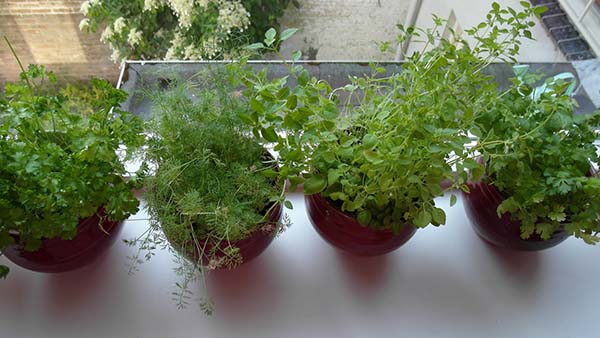
Content
- 1 What greens can be grown at home on a windowsill: suitable varieties of juicy greens and herbs for growing at home
- 2 Features of growing some types of greenery on the windowsill
- 3 How to sow or plant greens on a windowsill: general rules for creating a garden bed in an apartment
- 4 Caring for greens on the windowsill: the main secrets of getting a good harvest in your home garden
- 5 When and how to harvest greens at home
What greens can be grown at home on a windowsill: suitable varieties of juicy greens and herbs for growing at home
In an apartment, namely on a window, you can grow the following types of herbs and herbs (suitable varieties are indicated in parentheses):
- basil (Clove, Yerevan, Dwarf, Lemon, Marquis, Purple);
Note! You can read in detail about how to grow basil at home,in this article.
- witloof or salad chicory (Danish, Cone, Rocket, Ekstrella, Express);
- mustard or sarepta (Freckle, Volnushka, Mustang, Prima);
- green onions or, as they say, onions on a feather (Bessonovsky, Chernigovsky, Rostovsky, Union, Spassky, Timiryazevsky);
By the way! About, how to grow green onions on the windowsill, you can read here.
- cilantro;
- coriander;
- watercress (Spring, News, Vitamin, Dansky, Dukat, Prestige);
- chard or beetroot (Scarlet, White Salver, Emerald, Beauty);
- mint;
About growing mint on the windowsill read in a separate article.
- parsley (Aster, Beads, Breeze, Sandwich, Sorceress, Gloria, Emerald lace, Curly, Plain leaf, Prima, Russian feast, Morning fresh);
Important! The site already has separate detailed material on growing parsley on the window at home.
- vegetable purslane (Golden, Kuzminsky Semko, Paradox);
- leaf lettuce or lettuce (Grand Rapids, Dubolistny, Lollo rossa, Lolla bionda, Odessa kucheryavets);
- celery (Vivacity, Zakhar, Kartuli, Gentle, Samurai);
- arugula (Emerald, Corsica, Koltivata, Solitaire, Poker, Rococo, Rocket, Sicily, Euphoria);
- rosemary;
Specific tips for growing rosemary at home are given in this article.
- dill (Grenadier, Gribovsky, Kibray, Richelieu);
detailed information about growing dill available on the windowsill by this link.
- chives (Bohemia, Velta, Medonos, Moscow early ripening, Khibinsky, Chemal).
- spinach (Bordeaux, Victoria, Virofle, Fat-leaved, Strong, Stoic);
Detailed information about growing spinach on the window you can get by reading this article.
- sorrel.
Note! When choosing planting material, it should be borne in mind that varieties of greens for growing at home should be:
- early maturing (with a short ripening period);
- resistant to low light;
- undersized.
Features of growing some types of greenery on the windowsill
- Basil the most convenient and fastest growingfrom cuttings germinated in water.
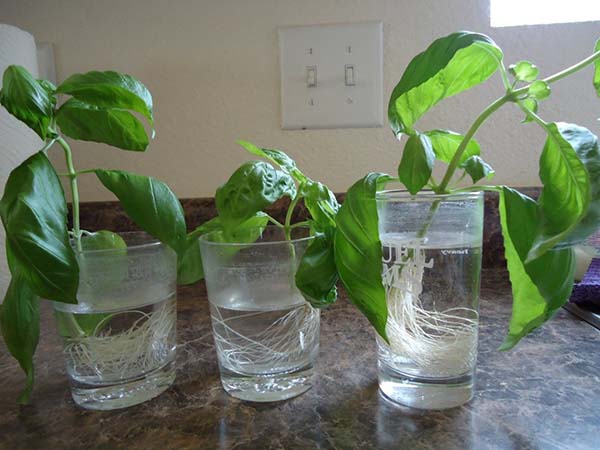
- It will not work to grow witloof (chicory salad) at home according to the standard scheme, because first you need to sow and grow root crops in the open field, and then they (root crops) can already be planted for distillation. In this case, they need to germinate in a cool (about 15 degrees) and dark room (a window sill or window will not work).
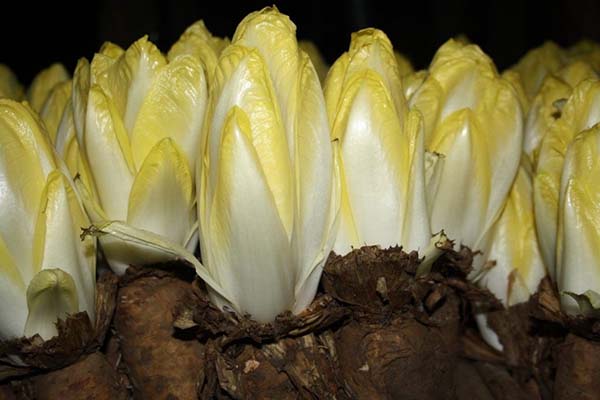
- Green onions convenient to drive, for example, in cans of water or many other ways you can read about in this article.
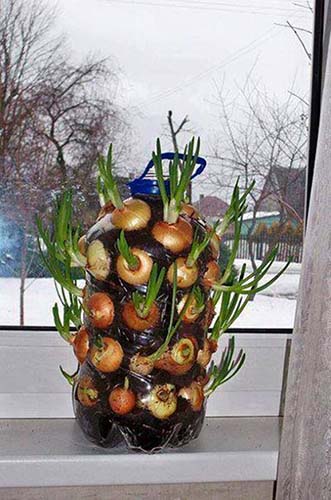
- Parsley and celery in winter it is better to sow not with seeds, but root out (soak for 2-3 hours in water and plant in the ground).
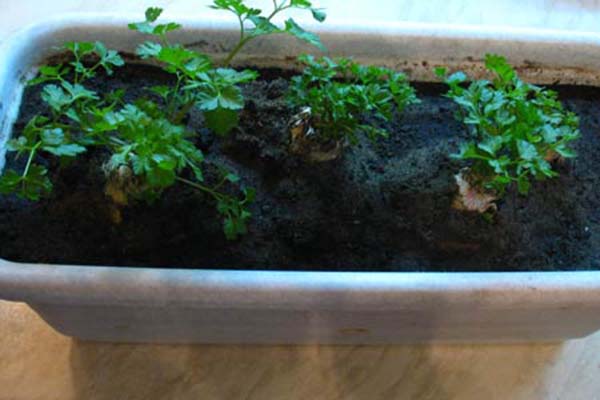
- Watercress and leafy mustard can be grownwithout land... You just need to put a layer of porous paper, cotton wool or a special hydrogel on the bottom of the landing container. Moisten the top and sow seeds over the surface, and in the case of watercress, this should be done as thickly as possible.
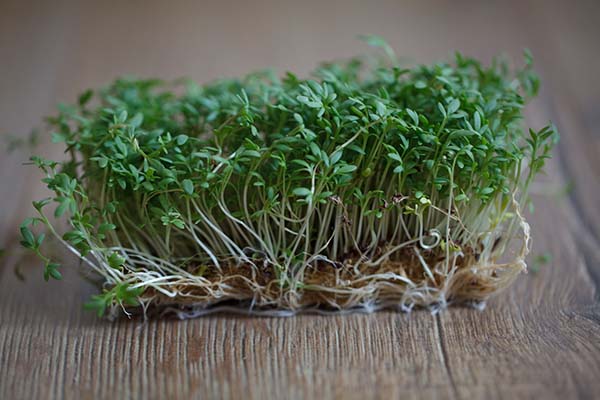
Important! If you want to practice, then first you should try to grow the most unpretentious fast-growing crops to care for (under the necessary conditions), which means that it is best for you to stop at the following: green onions (per feather), watercress, lettuce, parsley, chives - onions, arugula and basil.
And here grow dill (you need a low temperature - 16-17 degrees and 14-hour daylight hours) and cilantro is a little harder and more troublesome, especiallywitloof.
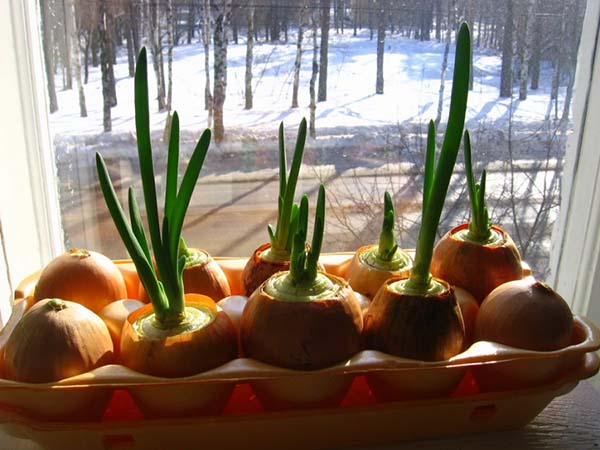
How to sow or plant greens on a windowsill: general rules for creating a garden bed in an apartment
When sowing greenery at home, as well as when planting indoor plants, you should take pre-planting measures, such as choosing planting containers (pots) and soil, as well as creating a drainage layer and preparing seeds for sowing, very seriously.
Planting containers
In principle, you can sow green seeds in any container, it all depends on how much crop you plan to grow. If you just want to try, then it will be logical to take small pots (greenery will look especially beautiful in flower pots). If you are going to sow a lot of seeds, then the containers are needed wider and more spacious (for example, you can take containers).
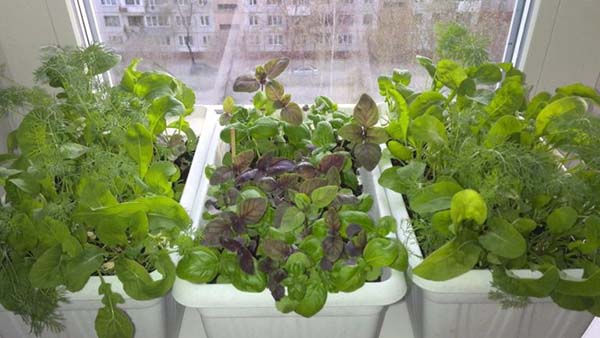
Important! Almost all greens tend to grow quickly, so you should not take pots that are too small. The minimum container height is 10-15 centimeters. In addition, the diameter must be sufficient. For example, to grow chard, you need a pot with a diameter of 30 cm. For other, simpler greens such as dill, parsley, spinach - much less (10-20 cm is enough).
Homemade greens will look especially attractive in hanging pots.
Soil
As always, you have 2 choices: dig up garden land (or even better forest land) or buy ready-made soil in the store. At the same time, one should not think that the first option is more budgetary and advantageous, because such land will be necessary without fail disinfect (eg, steaming in the oven or microwaveor spill with a pink solution of potassium permanganate or Fitosporin), and fertilize to improve its fertility. Let's say you can add wood ash. Among other things, ash is a good deoxidizer, because the soil for greenery should not be acidic.
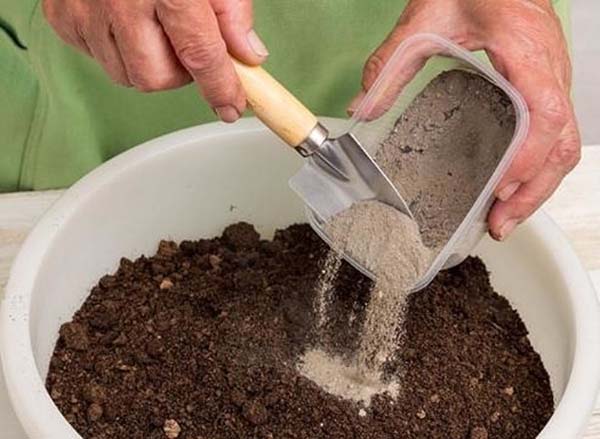
To grow green crops, you need an air- and moisture-absorbing soil (light and loose), supplied with all the necessary micro and macro elements. Therefore, if you buy an ordinary universal substrate, then it is advisable to add a little river sand and perlite (vermiculite) to it. It is also imperative to add humus to the garden soil.
Drainage
First of all, a drainage layer should be laid on the bottom of the planting pit (this can be shards from ceramic products, expanded clay, pebbles, gravel, crushed stone, brick chips or broken brick, coarse river sand), at least 2-3 centimeters thick.
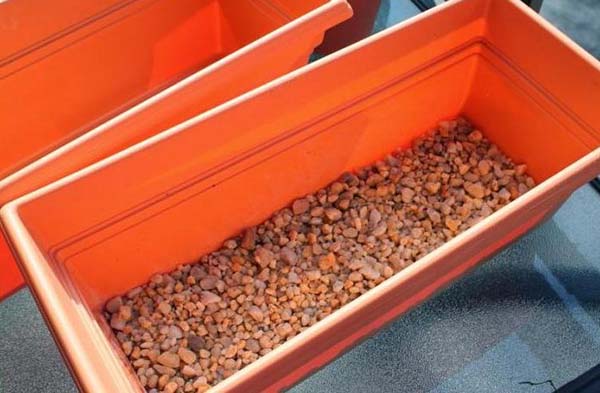
Reiteration! Drainage is needed so that water does not stagnate in the ground. Thanks to the drainage layer, air exchange is noticeably improved, root rot, soil acidification, and the formation of mold are prevented.
Seed preparation
For example, in order to accelerate the germination of dill seeds in the ground, they should first be soaked in warm water for 1-2 days (on a wet napkin). It is even better to germinate parsley seeds (this will take about 2-3 days).
By the way! For better germination and rooting in water, you can add honey (1 teaspoon for 1 liter of water).
But there is usually no special need to prepare for sowing the seeds of lettuce, basil, cilantro and spinach, chives, rucolla. However, at will, it is possible and even necessary to prepare them.
Important! Preparing seeds for planting is a recommended activity, but if you are used to sowing without soaking (in water or special preparations) or germination, then you do not need to do this. However, carrying out these procedures significantly increases the likelihood of a successful outcome, namely, the speed of germination (it is obvious that dry seeds germinate longer) and the further active development of plants.
Video: how to grow greens on the window - seedbed preparation and sowing seeds
Direct sowing
Step-by-step instructions for sowing greens for growing on a windowsill at home:
- Choose a suitable container.
- Lay out a drainage layer (at least 2-3 cm).
- Fill the planting container with prepared soil.
Important! It is impossible to fill the pot completely with earth (i.e. to the very edges), it is imperative to leave 2-4 cm so that the water does not spill out during watering.
- Moisten the earth by slightly spilling it with warm (room temperature) water.
- Sow seeds (superficially, in holes or grooves).
Pay attention to the features for different greens! Seeds parsley, dill, lettuce, basil, arugula, chives you can just sow evenly over the soil surface, randomly scattering at close range (better thicker, since germination is by no means 100%). Or you can sow in very shallow (up to 1 cm) grooves (lines)... And here are the seeds spinach and cilantro sow better in separate holes (1-1.5 cm deep), at some distance from each other (at least 5 cm). Seeds chard - to a depth of 3-4 cm.
- Sprinkle lightly with earth (i.e. cover with just a couple of millimeters).
- Spill water again.
Advice! In order not to wash out or excessively deepen the seeds, it is better to moisten the soil surface with spray bottle. In this case, it is advisable to use warm water.
- Cover crops with plastic wrap or a bag (you can also use a shoe cover) to achieve a greenhouse effect.
- Put in a warm (the warmer, the faster the shoots will appear) and not necessarily a bright place.
When the first shoots appear, it is recommended to quickly rearrange the containers to the light (on the southern windowsill or under artificial lighting).
Video: how to sow greens and grow at home
Caring for greens on the windowsill: the main secrets of getting a good harvest in your home garden
To grow a rich harvest of greenery on the window, you should create all the necessary conditions for comfortable growth and development at home.
Important! Your little boyfriend is requiredopen for airing almost every dayso that too much condensation does not collect inside (causing mold to form). And hereyou can completely remove only after the shoots appear, and it is better to do this gradually, allowing the greenery to get used to (adapt) to the changed conditions (light, moisture).
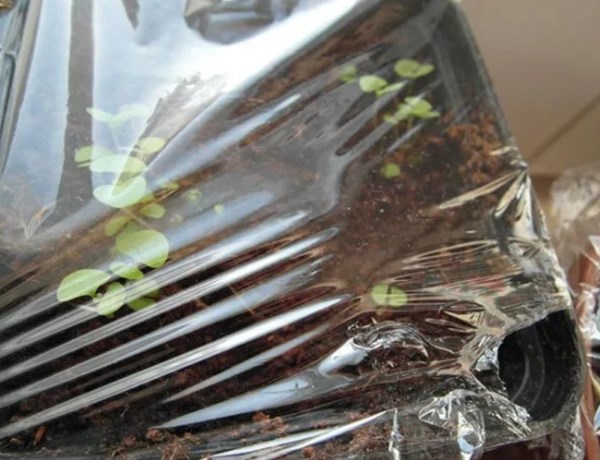
Place in the apartment: lighting, temperature and more
Sufficient daylight hours are one of the main, if not the main conditions for the successful cultivation of any greenery at home. So if you sow green in winter, then additional lighting is indispensable.
Important! For normal growth and development of greenery at home, it is required 12-14 hour daylight hours (the minimum is 10 hours).
Grow greens at homeall year round you will be allowedspecial lamps (phytolamps) orthe most common LED or fluorescent (incandescent lamps are not suitablesince give off too much heat). They must be turned on every morning and evening, as well as on very cloudy autumn-winter-spring days.
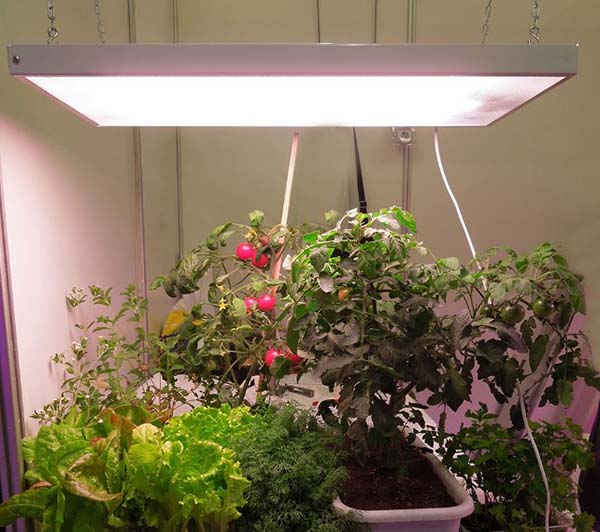
Note! Artificial light should fall on the plants from above, and not from the side.
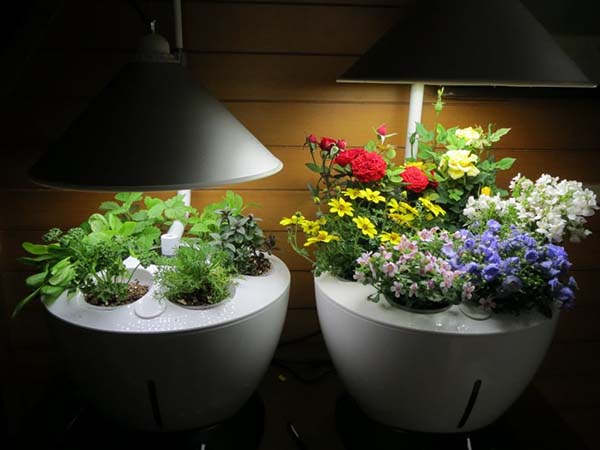
It's another matter if you decide to grow greens on the windowsill in late spring, summer or early autumn, when the length of daylight hours is quite sufficient. In this case, the best place would be southern (or southwestern, western) windowsill or balcony (loggia).
Important! Direct sunlight is very undesirable, otherwise your greenery will simply burn out. Therefore, planting (especially in summer) is recommended to be shaded (curtains) or set aside / rearranged.
In order for the plant to develop harmoniously (from all sides), do not forget periodically twist containers, turning in different directions to the light (if you have a long pot, then at least 2 sides).
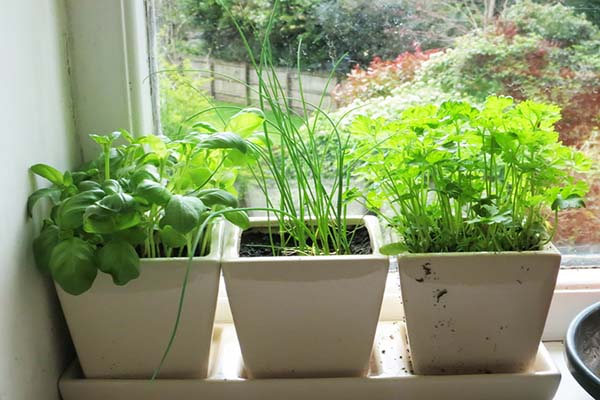
By the way! Chives are the only plant that practically does not need additional lighting.
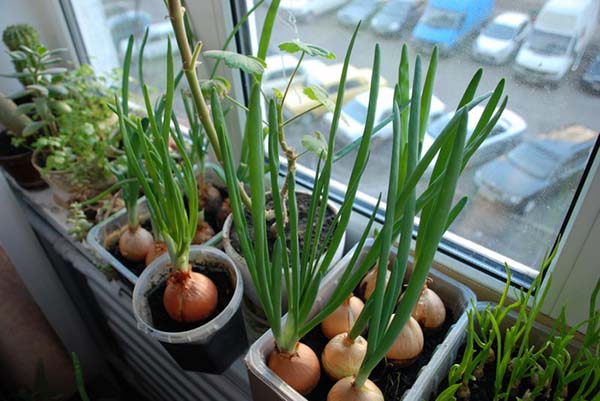
It is also very important that the greens did not suffer from drafts (the windows must be airtight) and excessively dry air (it is not necessary to put the pots close to heating devices, but it is better to cover them with something at all).
Worth knowing! Not very suitable conditions for growing greens are formed on the windowsill: it pulls cold from the window (drafts), and the batteries are “fried” from below with might and main.
It is optimal to place a home garden on a table specially designated for this purpose., of course, under the lamps. In principle, it is very convenient to set aside for a home garden place on the balcony or loggia (there will definitely not be problems with dry air due to batteries). Unfortunately, however, it can be too cold there.
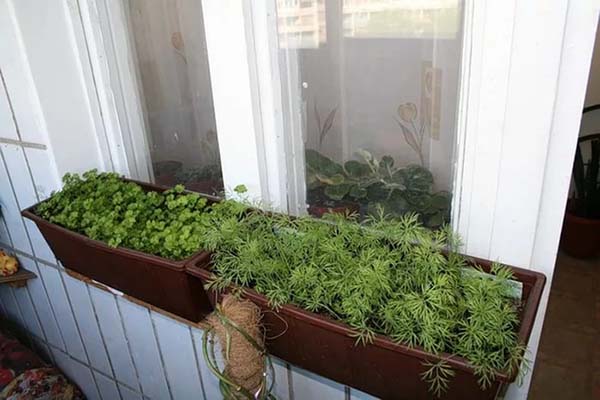
As for the optimal temperature, remember under what conditions greens grow in an open field or greenhouse. Plus, don't forget that plants need fresh air. But periodic temperature changes (hypothermia or too high temperatures) will definitely not benefit them.
At all, ideal conditions for greenery - this is a temperature in the region of 15-20 degrees and good lighting for 12-14 hours, as well as moderate soil moisture (about which later).
Watering
The rules for watering greenery grown on the window practically do not differ from those growing in the garden. Watering should be carried out regularly, avoiding both drying out and waterlogging of the soil (you need exactly moderate humidity). The very frequency of watering, of course, will also depend on the structure of the soil, and on the very type of greenery.
Advice! For irrigation, use only settled water at room temperature. It is absolutely impossible to water with cold water.
For example, basil loves moisture very much, and it should be watered every day (and preferably in the morning).
When, after the appearance of the first shoots, you remove the shelter, then during the first 2 weeks, seedlings should be sprayed with a spray bottle, and not pour from a watering can, even from the smallest. Further it is better to use a sprayer for wateringbecause this way you can also saturate the green leaves.
Important! If you have very dry air (due to central heating), then regular spraying is a must.
The optimal level isair humidity 60-75%.
Loosening
To improve the access of oxygen and moisture to the plant root system, the soil in pots should be loosened at least occasionally. This will also keep the roots from rotting.
Picking or thinning
It is obvious that by planting with a margin, in other words, thickened, you get thickened seedlings that will not be able to develop normally in the future, because they will not only lack space, but also light. The fact is that they will simply shade each other, which means that they should be subsequently thinned out, leaving the strongest.
Note! It is highly recommended to thin out the following green crops:lettuce, Swiss chard, arugula... So, the Swiss chard is thinned for the first time immediately after germination, and the second time after the appearance of 3-4 leaves, leaving 15-20 cm between shoots. Arugula should be thinned approximately 8-10 days after germination.And here no need to thin out dill and parsley, they can grow quite densely, especially watercress (it should grow as densely as possible).
Top dressing
You can feed home greens with any complex mineral fertilizers with an increased (predominant) nitrogen content, because it is he who is responsible for the green mass gain by the plant. For example, such popular fertilizers as "Kemira Universal" or "Gumi" are suitable.
Top dressing must be carried out only in liquid form.
When and how to harvest greens at home
You can understand that the greens are ready for cutting by their appearance or simply by pinching off the leaf for a sample.
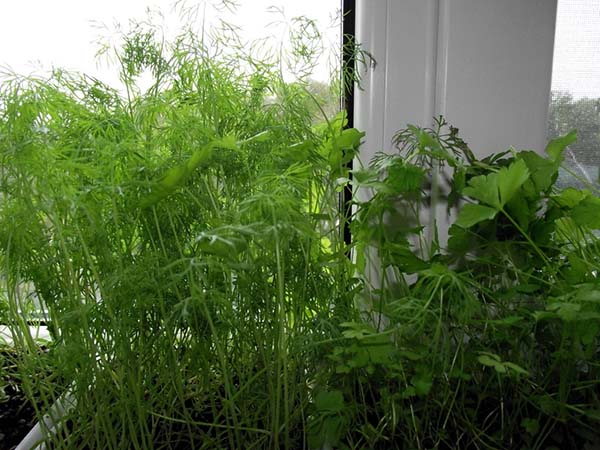
The main guidelines for the readiness of greens for harvesting (days after germination and / or reaching certain sizes):
- watercress - reaching a height of 7-10 cm (after 21-28 days);
- lettuce leaves - reaching a length of 3-4 cm (after 21-28 days);
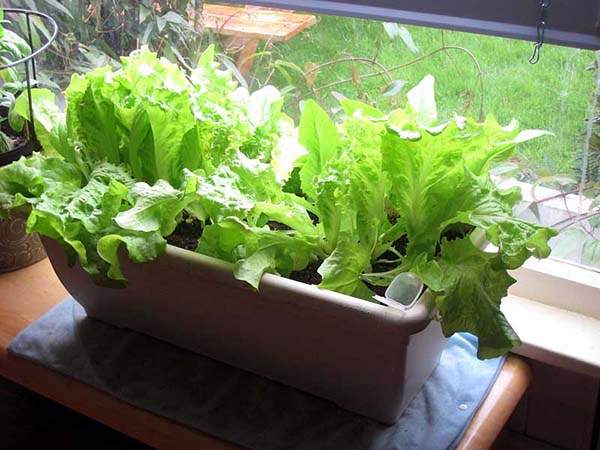
- spinach - after 30-35 days;
Important! Spinach leaves can be cut until the peduncles appear (after which they become bitter and less useful).
- arugula - after 21-28 days;
- vegetable purslane - after 3-4 weeks (21-28 days);
- Swiss chard - after 45-60 days;
A few tips for harvesting homemade greens:
- You should not cut (and it is better to carefully tear off) more than 1/2 of the green mass of the plant at a time.
- Every time you cut (rip off) greens, be sure to do a little feeding so that the plant has the strength to grow new green mass.
As you understand, having your own mini-vegetable garden on the windowsill (including in winter), consisting of fragrant and juicy greens, is not so difficult. Another thing is that you need to find a suitable place, as well as observe the basic rules for growing and maintaining the necessary conditions for the successful growth of green crops.
Video: growing greenery in winter in an apartment


Thank you. Very useful to know.